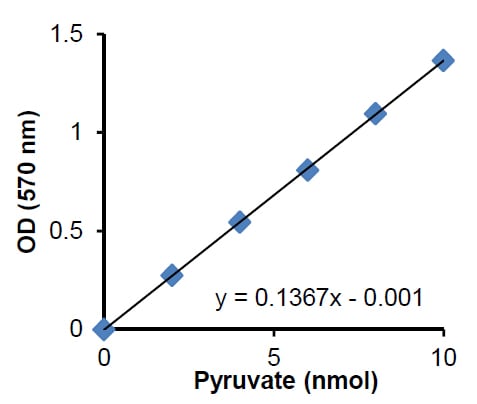Pyruvate Assay Kit (ab65342)
Key features and details
- Assay type: Quantitative
- Detection method: Colorimetric/Fluorometric
- Platform: Microplate reader
- Assay time: 40 min
- Sample type: Cell culture extracts, Other biological fluids, Plasma, Serum, Tissue Extracts, Urine
- Sensitivity: 1 µM
Overview
-
Product name
Pyruvate Assay Kit -
Detection method
Colorimetric/Fluorometric -
Sample type
Urine, Serum, Plasma, Cell culture extracts, Other biological fluids, Tissue Extracts -
Assay type
Quantitative -
Sensitivity
> 1 µM -
Range
1 µM - 200 µM -
Assay time
0h 40m -
Product overview
Pyruvate Assay Kit (Colorimetric/Fluorometric) ab65342 provides a simple, direct and automation-ready procedure for measuring pyruvate concentration in various biological samples such as blood, cells, culture and fermentation media, etc.
In the pyruvate assay protocol, pyruvate is oxidized by pyruvate oxidase via enzyme reactions to generate color (λ= 570 nm) and fluorescence (at Ex/Em = 535/587 nm). Since the color or fluorescence intensity is proportional to pyruvate content, the pyruvate concentration can be accurately measured.
The kit detects 1-200 µM pyruvate.
Pyruvate assay protocol summary:
- add samples and standards to wells
- add reaction mix and incubate for 30 min at room temp
- analyze with microplate reader -
Notes
Abcam has not and does not intend to apply for the REACH Authorisation of customers’ uses of products that contain European Authorisation list (Annex XIV) substances.
It is the responsibility of our customers to check the necessity of application of REACH Authorisation, and any other relevant authorisations, for their intended uses. -
Platform
Microplate reader
Properties
-
Storage instructions
Store at -20°C. Please refer to protocols. -
Components Identifier 100 tests Pyruvate Assay Buffer WM 1 x 25ml Pyruvate Enzyme Mix (Lyophilized) Green 1 vial Pyruvate Probe (in DMSO) Red 1 x 200µl Pyruvate Standard (100 nmol/µl) Yellow 1 x 100µl -
Research areas
-
Relevance
Pyruvate is a key intersection molecule in the netwrok of metabolic pathways. Pyruvate can be made from glucose through glycolysism converted back to carbohydrates via gluconeogenesis, or to fatty acids or energy via acetyl CoA. It can also be used to construct the amino acid alanine and be converted to ethanol. Glucose is converted to pyruvate which is then converted into acetyl CoA, the main input for the citric acid cycle (TCA). If insufficent oxygen is available, pyruvate breaks down anaerobically, creating lactate in animals and ethanol in plants and microorganisms.
Images
-
Pyruvate measured fluorometrically in mouse tissue lysates showing quantity (nmol) per mg protein of tested sample
-
 Functional Studies - Pyruvate Assay Kit (ab65342) Kaur, Gursharan et al., Scientific reports vol. 7,1 11645., Fig 2, doi:10.1038/s41598-017-12004-3Pyruvate levels under manganese stress and iron supplementation were measured with ab65342 and the results were plotted as a function of normalized absorbance at 450 nm per milligram of cellular proteins.
Functional Studies - Pyruvate Assay Kit (ab65342) Kaur, Gursharan et al., Scientific reports vol. 7,1 11645., Fig 2, doi:10.1038/s41598-017-12004-3Pyruvate levels under manganese stress and iron supplementation were measured with ab65342 and the results were plotted as a function of normalized absorbance at 450 nm per milligram of cellular proteins. -
Pyruvate measured colourimetrically in mouse tissue lysates showing quantity (nmol) per mg protein of tested sample
-
Pyruvate measured fluorometrically in biological fluids showing quantity (nmol) per mln of tested cells
-
Pyruvate measured fluorometrically in biological fluids showing quantity (nmol) per mL of tested sample
-
Pyruvate measured colourimetrically in biological fluids showing quantity (nmol) per mL of tested sample
-
Pyruvate colorimetric standard curve.
-
Pyruvate fluorometric standard curve.




















